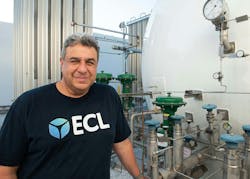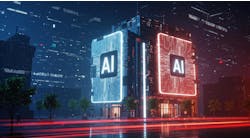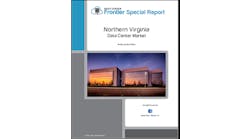Yuval Bachar has a big vision for hydrogen-powered data centers. In coming years, Bachar hopes to deploy hundreds of megawatts of highly-sustainable data center capacity alongside hydrogen pipelines and solar power arrays.
"It's a mission," said Bachar, the co-founder and CEO of ECL. "We believe we have the greenest solution in the industry."
At a moment when demand for AI computing power is outpacing the supplies of data center capacity and renewable energy, Bachar believes ECL offers a unique sustainable option - repeatable modular data centers, powered by hydrogen and built using 3D printing technology.
It is a big rethinking of how data centers are built and powered, the kind of moonshot that has always been difficult in mission-critical IT. But ECL’s offering arrives as AI is reshaping the data center landscape, prompting openness to new approaches.
Hydrogen has long been seen as a potential fuel to power a clean revolution, but hydrogen fuel cells have remained elusive as a production option, lacking the economics and scale for data center production. Over the past several years, innovators have sought to close that gap.
This month ECL has reached a key milestone, delivering its first production data center using hydrogen as its primary power source in Mountain Views, Calif. The company also announced an additional $10 million in funding led by Hyperwise Ventures, which will be used to accelerate research and development and expand the company’s global footprint.
Cato Digital Leases Full 1 MW Facility
ECL's MV1 facility in Mountain View was envisioned as a proof-of-concept colocation site where customers could experience hydrogen power. This week the company said the site has been fully leased to AI hosting specialist Cato Digital, which will pack 1,800 GPUs into 22 racks, running 1 megawatt of capacity in about 1,000 square feet.
The facility will be off-grid, with no utility power connection, and is expected to operate at a PUE of 1.1, comparable to the energy efficiency of the largest cloud data centers. ECL uses rear-door heat exchangers to cool its racks, supporting power densities of 75 kW per cabinet. ECL uses two cooling loops, one using water output from the hydrogen fuel cell, and a backup loop.
“The rapid expansion of AI has put incredible strain on global data center power capacity,” said Dean Nelson, the CEO of Cato Digital. “Building more of today’s current data centers won’t solve it. We have to rethink how to deploy dense compute to serve this unprecedented growth."
"ECL is uniquely positioned as they have redesigned the data center from the ground up," said Nelson, who is also the founder of Infrastructure Masons. "It is setting a new standard for excellence in the design, development, and delivery of hydrogen-powered data centers today, not years from now."
Data Centers Explore Hydrogen Power
A 1-megawatt facility and $10 million in funding may seem like a modest launchpad for a data center revolution. But ECL's effort is being closely watched by leading players in digital infrastructure, who yearn for sustainable options to address a looming gap in capacity and green energy.
That interest is tied to the track record of Bachar, who has held data center leadership positions with Microsoft, LinkedIn, Facebook, Cisco, and Juniper Networks. He was also a founder of the Open19 project, which creates open hardware designs for enterprise users.
Bachar sees the Mountain View facility as a down payment on a larger vision to bring hydrogen power into the mainstream of digital infrastructure. Bachar sees hydrogen as the most sustainable path forward for data centers and founded ECL to advance that mission.
The concept is to run the data center using a hydrogen fuel cell, which outputs electricity to power the servers and water to cool them. This approach offers the potential for a zero-emission site with no impact on local water supplies.
ECL’s approach builds on efforts at Microsoft, which began testing hydrogen generators in 2020 as an option to reduce its reliance on diesel fuel. Microsoft has yet to announce the use of hydrogen in a production data center, aside from a 48-hour test at a facility in Cheyenne earlier this year.
The MV1 facility is built as the “ECL 1.0” design to deliver a working prototype of the hydrogen system and cooling design. It is a retrofit of a building in Mountain View, which will operate with no grid connection while relying on four power sources:
• A primary fuel cell using hydrogen.
• A high-capacity battery.
• An emergency service generator.
• A secondary fuel cell using hydrogen.
ECL plans to use grid in the future and then optimize a mix of power depending on customer preferences for sustainability and cost.
An Ambitious Next-Generation Design
Now that MV1 is complete and fully-leased, Bachar is focused on the “ECL 2.0” design, which will feature significant improvements to the efficiency and capacity of hydrogen generation, allowing ECL to support larger blocks of capacity.
There will also be improvements to cooling, pushing the upper limit of rack density from 75 kilowatts to 125 kilowatts per rack which ECL believes will be sufficient for the 2025 to 2026 period.
“Today everyone wants to use cool air,” said Bachar. “The next generation we will need to have direct-on-chip cooling.” The 2.0 design will continue to support rear-door heat exchangers, which can operate in the same enclosure as direct-to-chip systems. “We think cooling will be hybrid for a long time,” said Bachar.
There will also be additional development of ECL’s software management system, which will integrate more AI and be agent driven.
ECL uses a built-to-suit model that can be optimized for customers, and plans to build out larger sites with 3D-printed data center modules in 1 megawatt blocks. Bachar said the company is in discussions with two 3D printing providers for the next-phase design.
The world’s first 3D-printed data center debuted in June in Heidelberg. Germany (see video) and supported 500 kW of capacity.
Hydrogen Agreements
While 3D printing is novel, the most notable innovation is the use of hydrogen. Bachar says ECL now has agreements with three leading hydrogen providers – Linde, Air Products and Air Liquide – that will give it national coverage in the U.S. for the next 10 years.
These agreements can help ECL deliver on its promised timeline of 9 months for data center deployment. He says that using 1 MW modules enables ECL to work with smaller-capacity electrical equipment like transformers and inverters, for which large-capacity units are in short supply.
The Mountain View facility will be supported by truck deliveries of hydrogen and an on-site storage tank. Larger facilities can be created by building data centers near hydrogen pipelines.
“There are more than 1,600 miles of hydrogen pipelines in the United States and ECL will select locations along those pipelines,” said Bachar, who cited Texas, California and Virginia as potential markets. “When we go to larger scale the pipelines can give us almost unlimited capacity.”
The Biden administration has a national hydrogen roadmap that calls for the creation of additional pipelines to support a hydrogen ecosystem to support the decarbonization of industrial facilities.
“The sourcing of hydrogen was a concern, but we're always going to have multiple suppliers of hydrogen,” said Bachar, who said ECL would be priced competitively, with pricing improving as its operation scales.
“I think there’s a much higher level of acceptance with hydrogen than there was just two years ago,” said Bachar. “It's not just data centers, as hydrogen will be coming into our lives. There's a significant amount of hydrogen out there.”
The primary availability issue is in the supply of “green” hydrogen, which is created using water and electricity from a renewable energy source and thus uses no fossil fuels. Green hydrogen is not yet widely available, and supplies will be limited for several more years.
The primary available commercial option is “blue” hydrogen, which is produced using natural gas. ECL says it will likely use blue hydrogen in its early projects, or even a “turquoise” combination of the two.
“We will build data centers for the next 20 years,” said Bachar. “We don't want to slow down that deployment, because we can switch from blue to green hydrogen once it is more available.”
Bachar said ECL may also deploy data centers near large solar arrays that offer the potential for on-site creation of green hydrogen.
Building a Sustainable Future
With the strong demand for data center capacity to support AI workloads, there is lots of interest in new approaches to data center power.
“Customer engagement is off the scale,” said Bachar. “We are flooded with requests for the large-scale requirements we are planning on for the next few years.
"The capacity situation is impacting the whole industry,” he added. "Traditional data center space is just not available. My view is that if we don't deliver enough AI space it will begin to slow down adoption.”
That has the potential to reorder some priorities in data center site selection.
"One shift we've seen in customer interest is that sustainability has become somewhat secondary to immediate availability of power,” said Bachar. "If we don't start now to build these in an efficient and sustainable way, we will be stuck with inefficient data centers for 20 years."
"We will make every effort to scale as fast as we can to create a footprint of green data centers,” he added. “We don't have time to wait until 2030.”







